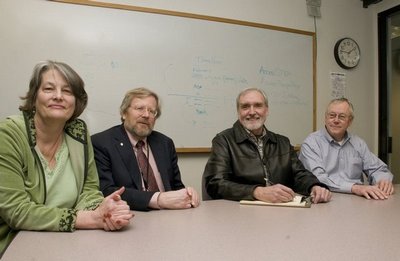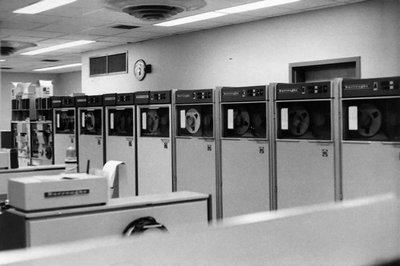Tom Profit and Sid McHarg of UW Technology recall meeting with networking experts from a major computing company in the mid 1980s. “We told them that we wanted to have their computers talk to our computers directly,” Profit said.
Their reaction? “‘Why in the world would you want to do that?'” McHarg quoted, causing his colleagues to erupt in laughter.
It may be hard to imagine the UW without the Internet, but Profit, McHarg, Pat Stark and Bob Kulp remember how the campus ran long before it was wired. That’s because this year, they all celebrate 40 years of working at UW Technology.
Computing technology was quite different in 1969, but Washington’s economic troubles and rising unemployment created an environment very similar to today’s recession. “There weren’t many jobs available,” said Kulp, who is a facilities planner for UW Technology Services. “Everybody was downsizing, laying off.”
Fortunately, a group of computing employees left UW to start a new company, creating vacancies at the Academic Computer Center. Kulp and McHarg, who is director of enterprise platforms at UW Technology, were both hired in March of 1969 as entry-level computer operators.
Stark, who is now senior facilities consultant at UW Technology, was hired at the same time as a key punch operator, punching data into cards for students who had assignments for classes in programming languages, like FORTRAN and COBOL.
Profit, who is director of strategic initiatives, began his 40-year career while he was still a student at UW. He had been working full-time at a computing company when he decided to apply for an in-house programming position. “I thought it would be a lot easier to come to the University once each day and just stay there for classes,” Profit said. “I never left.”
The group has witnessed countless leaps that technology has made in the past 40 years. University processes that are now simple and efficient, thanks to modern computers, used to be frustrating and time-consuming endeavors.
For instance, course registration was wildly inconvenient compared to the online registration tools students have now. Students used to wait in long lines to handpick their courses from big tub files filled with course cards. In the early 1970s, the UW began using mark sense forms, which could be scanned by a machine, to make the registration process faster and more efficient. “That was seen as a great improvement,” said McHarg. “It meant you weren’t spending the first week on campus getting registered.”
But this method also meant lots of work for computing employees. “There used to be whole bevies of terminals that were set up all over campus just for the registration period,” said McHarg. “A whole floor in the basement of Odegaard Undergraduate Library was set up. That was always a great challenge, to get all the connections made and the equipment put out in time. You were basically putting together this whole room with terminals, and then taking it down at the end of the change period, only to go through the same exercise a couple months after that time.”
Students weren’t even allowed to touch the terminals back then, according to Profit. Terminal operators were “little old ladies in tennis shoes — that was the image portrayed,” he said. “[The department] needed more than 80 of them, and [the same] women did that for years and years.”
As technology advanced, the Academic Computer Center trained students and faculty how to use terminals on their own. “Everybody was new to it,” Kulp said. “Eventually, as the University got very educated on the nuances, a lot of the departments started taking over their own training responsibilities.”
And now, very few members of the UW community need help operating a computer. “The University used to teach people computer languages, and now they expect the students, when they arrive, to already know how to deal with the tools that are ubiquitous,” Profit said.
Of course, computing is much easier now that computers don’t take up entire rooms — or even floors. “You’ve got more computing power on your desktop or laptop than you would have on a whole floor,” Stark said. “It’s just incredible. You would have to see it to believe it.”
McHarg explained that, 40 years ago, a giant, state-of-the-art storage disk subsystem the size of five refrigerator cabinets would hold about 36 megabytes of information. Now, a hard drive that holds a terabyte of data — one million megabytes — can be held in your hand.
Undoubtedly, the advancement that has most affected the University is the Internet. Students, faculty and staff have fast, easy access to information and resources that they couldn’t dream of 40 years ago.
Profit said the first on-campus network was started in the mid-70s and connected to UW corporate data associated with all major financial and student administrative applications. But the UW really began going online in the early 90s. The University drastically cut down on paper usage when it began moving information onto the Internet, he said.
“I think for the last 10 years, there have been really no new paper reports,” Profit said. “In the student area, there were massive amounts of reports that were done by the registrar’s office and then distributed to the various colleges and departments on campus, like class lists — that’s all online now.”
Stark, who now works with architects and engineers to make sure that new buildings and remodels have the infrastructure needed to support today’s technology, recalled all the work it took to wire the UW campus.
“We did a lot of cable installation — running cable through the campus tunnels to connect buildings to the campus network that was housed in the Academic Computer Center,” she said. “We also had telephone lines installed and managed this service so people could ‘dial-in’ from off campus. While it started off in small bits, it has morphed itself into what you see today — campus-wide access to the worldwide Web.”
So what has kept these UW Technology employees around for so long?
“The University is an incredible place to work,” Kulp said. “I’ve never not wanted to come to the University to go to work, any day.”
Stark agreed. “It’s a learning environment, it’s a beautiful campus, the people are nice and there’s a real mission here,” she said. “Everybody has frustrations, everybody has bad days, but on the whole, it’s a wonderful place to be and I’m very grateful that I’ve had the opportunity to be here this long.”
Kelli Trosvig, interim chief operating officer of UW Technology, said, “They all have a sense that they’re contributing not just to UW Technology, but to the campus as a whole in the work that they’re doing. They work incredibly hard and take a sense of pride in contributing to our mission of discovery and sharing.”
Trosvig said the group will be honored at a UW Technology service award event sometime in May.

